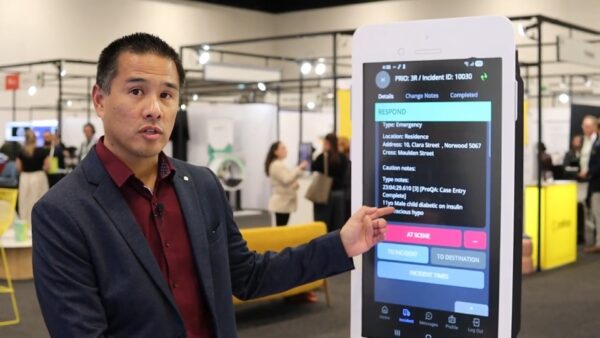We live in a world surrounded by data – and emergency services is no exception.
Throughout the patient journey, a wealth of data is generated and collected relating to the operations and control centre, the paramedics, the vehicle, and the clinical handover. This data complexity ranges from relatively simple data, such as real-time visibility of vehicles and current status, to more complex data such as predicting likely response times based on current vehicle locations, predictive wellbeing trends, and forecasts derived from historical data for an area.
There are different types of information available that might not have obvious impacts on response times but are still important to analyse such as vehicle defects, and vehicle performance anomalies.
The right data needs to be captured to make the right decisions at the right time, at the right place. Having the right data allows you to make better-educated decisions. Decisions based on facts, instead of anecdotes.
So, what can your data tell you?
The Connected Control Centre
One of the most critical control centre data streams is real-time resource availability, especially vehicle location and status. For example, how many vehicles are currently responding to incidents, and what is the average response time?
Rolling response time data tells the control centre about average response times and outliers, and locations, or times of the day or week that require more resources. For example, there might be a catastrophic event that has suddenly increased Priority 1 jobs. Real-time data informs operations they need to quickly re-assign some lower-priority patient transport jobs and make more first-line vehicles available. This detail is invaluable when responding to issues as they happen and informing the best possible decisions.
Figure 1 shows job response time distribution – where a large proportion of jobs achieved a 15 minute or better arrival to the scene from an emergency call. The dials on the right show an average response time of 22 minutes, with 50th and 90th percentiles – in real-time. The data also shows job response performance and trends across two-hourly intervals (at bottom) and is easily compared against Key Performance Indicators.

Other useful control centre data insights include:
- Hospital wait times: what are the patient offload waiting times at each hospital? This information indicates ambulance availability for other urgent responses.
- Resource planning: based on real-time geographical heat maps, future needs are predicted from historical data like previous response times, total job lengths, hospital wait times, and idle times.
- Vehicle location and messaging: a full data history enables authorities to find out where and when more resources might be needed, at what times.
The Connected Paramedic
Paramedics need data to manage demanding situations during incident response. Real-time, emergency communications in the field provides paramedics with enhanced safety and situational awareness. Real-time intelligence sent to a paramedic en route, such as location, status, and medical condition(s) allows them to arrive at the scene informed, treat patients accurately, and transport them to the right clinical destination (Figure 2).

Figure 2 Current vehicle location
Other useful paramedic data insights include:
- Pre- and post-shift and compliance procedures: accurate and auditable records of procedure completions, consumable/PPE requisitions, and restricted medicine access and use.
- Incident analysis: when, where, and what times are duress alarms activated?
- Paramedic wellbeing: accumulated stress factors, such as overtime, meal break timing, breaks between Priority 1 jobs, and continuous monitoring of mental health ratings.
The Connected Vehicle
The vehicle is the central communications hub, with aggregated data exchanged between other parts of the Connected Journey. In addition, vehicle data also provides fleet management benefits. While not obvious, vehicle availability also affects response times. More available vehicles mean more resources for incident allocation.
Vehicle status dashboards source telemetry and telematics data, like that shown in Figure 3. Data that falls outside defined parameters automatically generates maintenance alerts that require attention outside of standard servicing schedules, such as washer refills, brake pad wear, tyre pressures, and fluid leaks.

Figure 3 Real-time vehicle information
Actions informed by this data helps improve vehicle reliability – reducing the number of breakdowns, while potentially extending the time between services. This alerts paramedics and the control centre of potential issues that affect vehicle availability, including those related to critical systems like duress alarms and sirens.
Ambulance authorities can determine if vehicle faults reported from a single ambulance cause issues for others. High and low-use vehicles can also be rotated to enable even vehicle usage across the fleet.
Other useful vehicle data insights include:
- Messaging: by analysing vehicle message distribution, authorities can analyse peak times (e.g., New Year’s Eve) to inform plans and share data loads across multiple providers to lower costs.
- Asset tracking: find out if critical equipment like defibrillators, stretchers, or medicines are missing or require replacement.
- Incident investigation: for example, vehicle movements in the lead-up to a crash event.
The Connected Clinical Handover
During incident response, if paramedics know a specific hospital is at capacity, then choosing another available hospital provides better patient outcomes by reducing wait times. Figure 4 shows an individual hospital, ambulance numbers and recent wait times.

Figure 4 Hospital locator and statistics
Once a hospital is selected, a paramedic could immediately transmit:
- Patient job category and criticality information.
- Real-time information such as ECG, pulse and oxygen saturation.
From the hospital’s perspective, staff could view:
- The number of incoming ambulances and criticality of incoming cases.
- Estimated arrival times enabling them to be prepared for the patient.
- Real-time clinical information captured by supporting systems in the ambulance.
This quick data transfer is potentially lifesaving and could help enable better decision making involving the receiving emergency department.
Trends are identified, and the factors influencing them can be investigated. Ambulance authorities can also view which hospitals are underutilised or overutilised. Both ambulance authorities and hospitals can then undertake resource planning to help reduce wait times and ramping.
Conclusion
Knowledge is power.
Combining the customer domain knowledge in partnership with a good technology partner can unlock the potential of data to transform ambulance authorities. The combination can produce good insights and demonstrate service delivery effectiveness, inform the Connected Journey at all stages and times, and help manage valuable vehicles and assets.
Data insights improve paramedic safety and wellbeing and support better patient outcomes. Being able to access the right data enables all Connected Journey stakeholders to make the right decisions at the right time, at the right place.

Tim Lawson
Senior Solutions Consultant
Meet the author
With over 20 years of experience, Tim has dedicated his career to strengthening the emergency services industry. Through Tim’s expertise in critical communications, systems integration, embedded mobile solutions, real-time data processing and data warehousing, he is focused on partnering with customers to deliver solutions and supporting information to help meet response targets, improve responder safety and make informed decisions to influence better community outcomes.



